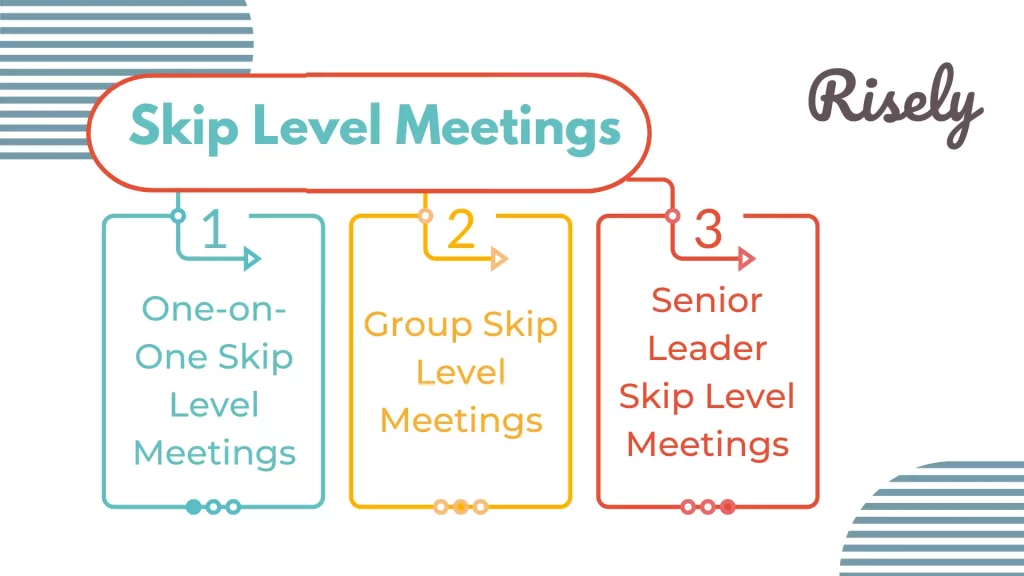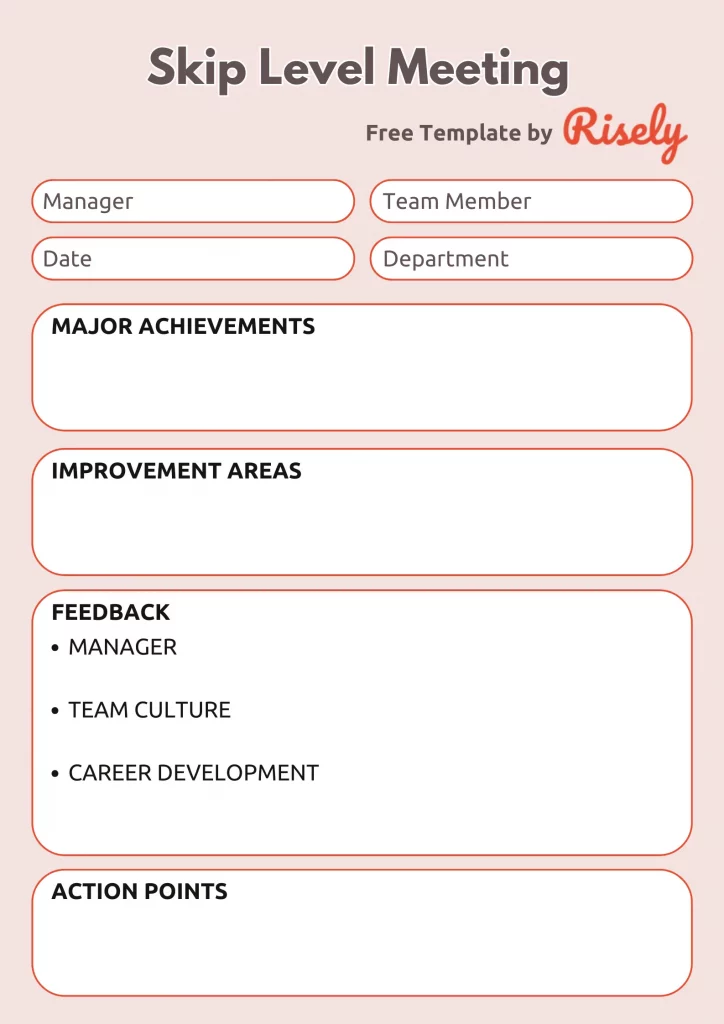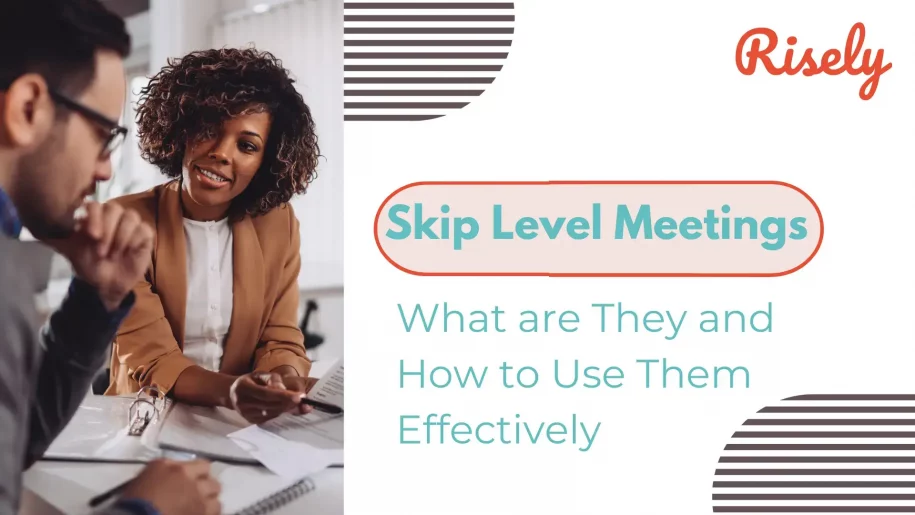Skip Level Meetings – What are They and How to Use Them Effectively?
Have you ever heard of skip-level meetings? These meetings are gaining popularity in the corporate world as a way for leaders to connect with employees beyond their direct reports. Skip-level meetings can be an effective tool to gain insights into the workplace culture, identify potential issues, and foster better communication and relationships with employees. This blog will explore skip-level meetings, the various types, and who should participate in them. We will also discuss how to prepare for a meeting, run an effective meeting, and manage feedback and follow-up after the meeting. Finally, we will share best practices for successful skip-level meetings that can help you strengthen your organization’s culture and boost employee morale.- Skip Level Meetings – What are They and How to Use Them Effectively?
- Understanding Skip Level Meetings: What They Are and Why They Matter
- Types of Skip-Level Meetings and Who Should Participate
- How to Prepare for a Skip-level Meeting?
- Running an Effective Skip-Level Meeting
- Skip-level Meeting Template (Free & Downloadable!)
- Examples of Skip-Level Meeting Questions for Managers
- Managing Feedback and Follow-Up After the Meeting
- Conclusion
- Other Related Blogs
Understanding Skip Level Meetings: What They Are and Why They Matter
Skip-level meetings offer a valuable platform for senior leaders to connect with lower-level employees, fostering understanding and rapport directly. These meetings align individual goals with the company’s objectives and allow employees to share challenges and potential solutions. Additionally, these meetings create a space for open conversations and valuable feedback.What is a Skip-level Meeting?
Skip-level meetings involve one-on-one conversations between employees and senior managers to whom they are not directly reporting, allowing employees to discuss long-term career goals and seek guidance. These meetings offer insights into the leadership style of upper managers and create a space to express gratitude for accomplishments. They are a constructive dialogue rather than a witch hunt. By setting up skip-level meetings, employees can understand how to effectively utilize this template to enhance communication with their skip-level manager and align with the company’s goals. Great skip-level meetings can be an excellent way to build rapport and foster a positive work environment.Benefits of Skip-Level Meetings
Skip-level meetings are a great way to improve employee engagement and demonstrate that their contributions are valued. These meetings provide a platform for employees to voice concerns or suggestions about day-to-day operations, fostering open communication. They also help employees understand the bigger picture and align their goals with the company’s. Additionally, these meetings uncover innovative ideas and perspectives from different levels of the hierarchy, enabling the identification of potential benefits and areas for improvement within the organization.Other Interesting Reads
Types of Skip-Level Meetings and Who Should Participate
One-on-One Skip Level Meetings
One-on-one skip-level meetings allow direct and open communication, allowing employees to discuss their day-to-day work, challenges, and career paths. These meetings foster trust and build strong working relationships, allowing senior leaders to understand team members’ perspectives. Direct managers may attend to facilitate the conversation and provide support, enhancing the effectiveness of these great skip-level meetings. Using a template or structure for these one-on-one meetings is a good idea, ensuring that time management is optimized and the sessions focus on achieving goals.Group Skip Level Meetings
Group skip-level meetings involve gathering a team or department to engage in discussions, fostering collaboration, brainstorming, and idea-sharing among employees at different levels. These meetings enable cross-functional learning and collaboration, focusing on larger team goals or addressing common challenges. Senior leaders play a facilitative role in encouraging participation. Group skip-level meetings are a great way to enhance teamwork, align with the company’s goals, and promote employee engagement. They create a platform for employees to interact with skip-level managers and colleagues, leading to productive and innovative outcomes.Senior Leader Skip Level Meetings
Senior leaders skip-level meetings involving direct interactions between senior executives and their managers’ managers. These meetings focus on team performance and its alignment with company goals. They ensure effective organizational communication, giving senior leaders insights into their managers’ challenges. Solutions to address concerns are discussed during these meetings. Senior leader meetings are an excellent way for top-level executives to connect with their managers’ managers and foster collaboration toward achieving the company’s goals.
How to Prepare for a Skip-level Meeting?
Research and Gather Information
The first step to a successful skip-level meeting is gathering all the relevant information about the individual or team you are meeting. It includes understanding their priorities, recent initiatives, and company updates. Taking help from their manager and incorporating their feedback can help you align all levels. Moreover, asking questions that enable you to clarify the employee’s position and needs is important to ensure that growth opportunities open for them. Consider collecting examples or data to support your points during the meeting and identify potential solutions to address challenges or improve processes.Set Clear Objectives and Goals
A clear agenda is needed to ensure the effectiveness of a skip-level meeting. Hence, it’s best to go to a meeting with clear goals and objectives that can become the critical points of the meeting’s agenda. Clearly define the purpose of the meeting and what you hope to achieve. It will ensure a productive conversation and help you focus on your desired outcomes. While setting up the agenda, you are taking care of your and your team members’ concerns – setting the base for a balanced discussion.Prepare a List of Topics and Questions
A good set of questions covering the basic ideas you want to cover during the meeting can help you step into the discussion quickly. These questions should be relevant to the employee’s role and the purpose of the meeting. Open-ended questions are particularly beneficial, encouraging detailed responses and facilitating a more meaningful discussion. Additionally, including questions about the employee’s long-term career goals and how they align with the company’s goals can provide valuable insights. Lastly, asking about the employee’s experience working with their direct manager and their thoughts on the company’s leadership style can help identify areas for improvement.Anticipate Potential Issues and Solutions
When preparing for a skip-level meeting, it’s important to anticipate potential issues or concerns the employee might bring up. Considering these, you can brainstorm possible solutions or steps to address them. It’s also essential to be prepared to discuss any recent changes or challenges within the team or organization. Additionally, consider how the employee’s feedback can improve day-to-day operations. Anticipating these potential issues and having solutions ready will help ensure a productive and effective skip-level meeting.Running an Effective Skip-Level Meeting
Creating a conducive atmosphere for skip-level meetings is crucial. Encouraging employees to share their thoughts and opinions during these meetings is essential. Active listening fosters trust and rapport while helping you better understand their perspective and experiences. Additionally, providing valuable feedback and guidance on their work and career development is essential. On the other hand, collecting feedback from the employee on the various aspects of their job that impact them daily is just as important. It is especially important for senior managers as it can uncover undetected issues.Establishing an Open and Productive Atmosphere
To establish an open and productive atmosphere in skip-level meetings:- Begin by expressing gratitude for the employee’s contributions and time.
- Create a safe space where they feel comfortable sharing their thoughts and concerns.
- Emphasize that the purpose of the meeting is to gain a better understanding of their experiences and perspectives.
- Approach the meeting as a one-on-one conversation rather than adopting a hierarchical mindset.
- Show genuine interest in the employee’s well-being and success. It will foster a positive environment for effective skip-level meetings.
Encouraging Honest Feedback and Discussion
Commonly, employees may feel uncomfortable during the initial skip-level meetings. Yet, overcoming this hesitation and fostering honest and open discussion is crucial to progress. A few things that you can do while conducting a skip-level meeting include:- Avoid leading questions or assumptions that may bias their responses
- Use active listening techniques to demonstrate that their input is valued.
- Seek clarification if needed to ensure a clear understanding of their perspective.
- Show appreciation for their willingness to share their thoughts. Nonverbal cues that demonstrate irritability or disagreement can undo your hard work here.
Addressing Concerns and Issues
Creating a safe and open space for employees to voice their concerns and issues is crucial in skip-level meetings. By asking follow-up questions, you can gather more information and understand the context of their concerns. Offering potential solutions or suggestions shows your commitment to addressing their issues. Additionally, discussing available resources or support can help resolve their problems. Remember to reassure employees that their concerns will be handled appropriately. Beyond reassurance, ensure that sufficient follow-ups are taken for the issues. It fosters a sense of trust and encourages honest communication.Skip-level Meeting Template (Free & Downloadable!)

Examples of Skip-Level Meeting Questions for Managers
- What are your thoughts on the company’s goals and how they align with your work?
- Can you provide examples of specific challenges or obstacles you face in your day-to-day work?
- How can the company better support your professional development and career growth?
- How can we ensure that you continue to feel valued and motivated in your role?
- What suggestions do you have for improving communication and collaboration within the team?
- Can you share any feedback or insights on your experience working with your direct manager?
- Are there any concerns or recommendations you’d like to share regarding the team’s management or leadership?
Managing Feedback and Follow-Up After the Meeting
During the skip-level meeting, taking notes to track important feedback and action items is essential. Summarize the main points discussed and share them with the employee for confirmation. Following up promptly on any commitments or promises made during the meeting is crucial. Communicate any decisions or actions taken due to the meeting to keep everyone informed. Regularly checking in with the employee ensures that their concerns are addressed effectively.Making Use of the Feedback
After receiving feedback from skip-level meetings, it is important to analyze the information to identify common themes or areas for improvement. This analysis helps in finding opportunities to implement changes or solutions based on the feedback received. Sharing the feedback with relevant stakeholders and decision-makers can drive organizational change. Considering how the feedback aligns with the company’s long-term goals and vision is crucial. Organizations can create a positive and productive work environment by using feedback to catalyze continuous improvement and growth.Taking Action and Addressing Issues
After a skip-level meeting, it’s crucial to prioritize the issues that the team members raised. It allows you to focus on the most critical areas that need attention. Develop action plans for each case systematically, ensuring that each step leads to progress. It’s crucial to involve the appropriate stakeholders and decision-makers in implementing the necessary changes. Communication is key – keep the employee informed of the progress and outcomes of the actions taken. Finally, continuously monitor and evaluate the actions’ effectiveness to ensure they achieve the desired results.Continually Reviewing and Improving the Process
Continuous revisions and reviews enable an efficient process for skip-level meetings. Seeking feedback from both managers and employees provides valuable perspectives on the meetings. Evaluating the frequency and duration of meetings based on team needs allows for adjustments that optimize their impact. Exploring innovative ways to enhance employee engagement during these meetings promotes a productive atmosphere. Continuously communicating the purpose and benefits of skip-level meetings to all stakeholders reinforces their importance. Sometimes, while conducting skip-level meetings, you are underprepared and lack several of the critical skills needed to run them effectively. Starting from active listening and effective communication to one-on-one meetings. But worry not; building these skills will not give you another headache because Risely is here to show your way to leadership development. Start now with a free assessment of your leadership skills on a journey that sets you apart from the crowd.Conclusion
In conclusion, skip-level meetings can be a powerful tool for effective organizational leadership and communication. By understanding their purpose and benefits and adequately preparing and running these meetings, leaders can gain valuable insights, address concerns, and foster open communication and collaboration. It is essential to establish an atmosphere of trust, encourage honest feedback during these meetings, follow up on the feedback, and take appropriate action. By continually reviewing and improving the process, organizations can ensure that skip-level meetings are utilized effectively and contribute to the overall success and growth of the company.Test your constructive feedback skills now for free!
Take the free constructive feedback assessment for managers to start a journey of growth.
Other Related Blogs
How to build and retain high performing employees? | Laletha Nithiyanandan
How to build and retain high performing employees? | Laletha Nithiyanandan Are you really an HR if you have not spent hours chasing the ideal high performing employees for your…
How Can You Build A High Performing Culture? 7 Hacks
How Can You Build A High Performing Culture? 7 Hacks We have all heard of dream teams and tried to build them with varying levels of success and failure. Among…
10 Effective Manager Performance Goals to Drive Team Success
10 Effective Manager Performance Goals to Drive Team Success You’re sitting across from a manager in a performance review meeting. They seem unsure, disconnected from the company’s vision, and oblivious…
How to Build a High-Performing Team?
How to Build a High-Performing Team? Creating a high-performing team is a goal that every organization aspires to achieve. A high-performing team achieves superior results and can quickly adapt to…


